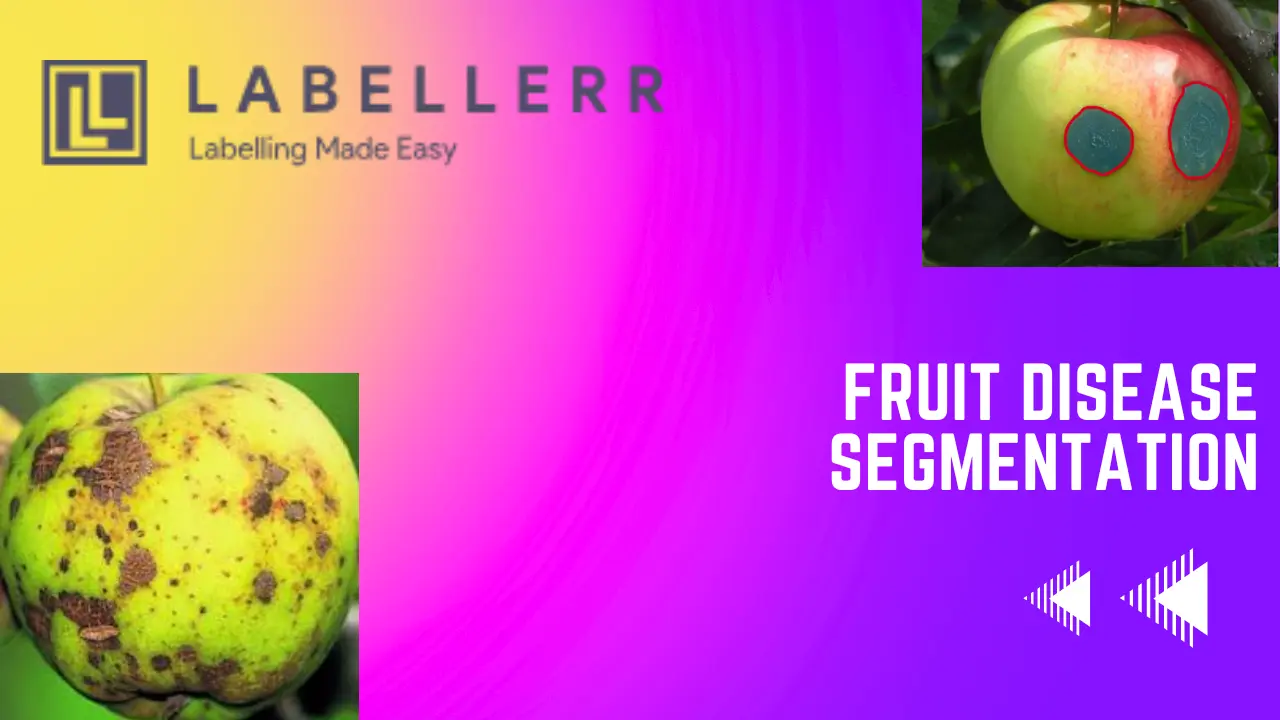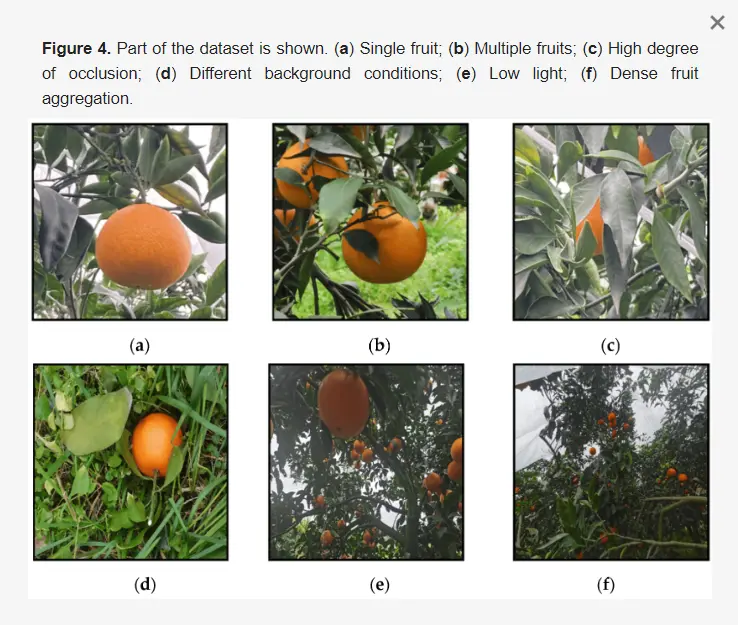Precise Fruit Disease Segmentation With Labellerr

According to a research conducted by the Food and Agriculture Organization of the United Nations (FAO), plant diseases cause 20-40% of global crop losses. Precise fruit disease identification provides a strong tool for mitigating these losses and increasing agricultural productivity.
With the advancement of computer vision technology, particularly in the field of precision agriculture, there is immense potential to revolutionize fruit disease detection and segmentation.
By using various algorithms and image analysis techniques, computer vision systems can accurately identify and segment diseased areas on fruits, enabling farmers to take timely remedial actions.
However, the development of accurate disease segmentation models relies heavily on the availability of meticulously annotated datasets.
Labellerr, a data annotation platform, offers solutions for annotating images of fruits affected by diseases.
Through its intuitive interface, advanced segmentation features, and collaborative annotation capabilities, Labellerr empowers agricultural professionals to create high-quality labeled datasets essential for training precise disease segmentation models.
Table Of Content
- Challenge In Fruit Disease Segmentation
- Solution Using Labellerr
- Conclusion
- Frequently Asked Questions
Challenges In Fruit Disease Segmentation
To automatically detect, fruit diseases, the model needs to be trained efficiently and precise annotation is necessary. Nevertheless, there are a number of difficulties in the annotation process for fruit diseases.
Data Ambiguity: Annotators face this when it is tough to make distinction among:
Initial phases of disease versus typical variations: In the initial phases of a disease, minor marks or discolorations can be mistaken for minimal blemishes or color variations in fruit that are present naturally.
For example, in the image below A is healthy fruit, B shows pulp flesh translucency symptoms, whereas C and D are the outer appearance of the Papaya where C is healthy, and D is flesh translucency but there is not difference between the two.

Annotators may use active learning approaches. The model detects the most doubtful data points (ambiguous situations) and requests annotators to label them specifically. This concentrates annotation efforts on the most relevant data, hence boosting model performance in distinguishing early disease from natural variations.
Coinciding Characteristics: There are other fruit diseases that can have identical symptoms or the image of the fruit gets hidden by branches, other fruits or leaves and it becomes difficult to identify the diseased part.
To distinguish between these, annotators may require other details such as fruit kind, geographic location, or climate. They may also mark only the affected region that is present in the image or they can mark the entire part while segmenting.
Problems with Image Clarity: The accuracy of annotations are directly affected by low quality images. For example, consider:
Low resolution: It becomes difficult to see the disease's details in blurry or grainy images, which makes it challenging to label them with confidence.
Uneven lighting: The visibility of disease in the image can be affected by lighting. This unique lighting in each image may need annotators to modify their classification criteria.
Annotators may use techniques such as random cropping, rotation, and color modifications to synthetically expand dataset size and improve model robustness to changes in lighting and image quality.

Class Imbalance: This happens when there is a notable difference in the quantity of images in a dataset between various illness classes. For example:
Rare vs. typical diseases: Compared to typical diseases, a dataset may contain comparatively few images of rare diseases. When a large dataset is labelled by annotators for a common disease class, they may eventually become tired and fail to notice small differences for rarer conditions.
To create a more balanced dataset, annotators may over-sample images from rare diseases while under-sampling images from common diseases.
Or they can train the model using a cost function that penalizes misclassifying rare diseases. This encourages the model to pay more attention to rare classes.
Time Restrictions: It can take a lot of time to annotate big datasets. Deadline pressure can result in the following:
Careless annotation: Raises the risk of mistakes or missing information.
Improper labeling: When annotators work quickly, they may apply labels inconsistently throughout the dataset.
The method of producing high-quality annotation is difficult and requires knowledge of image segmentation techniques and fruit diseases. A big dataset including a variety of images might be costly and time-consuming to annotate.
Addressing these challenges requires comprehensive approaches that integrate advanced technology, accurate data annotation, and effective disease management practices to mitigate the impact of fruit diseases on crop health and agricultural productivity.
Why we need to work on fruit diseases?
Rotten or diseased fruits pose several problems beyond segmentation challenges.
They can lead to significant economic losses for farmers due to reduced marketability, decreased yield, and increased susceptibility to secondary infections.
Also, diseased fruits may compromise food safety and quality, posing risks to consumer's health and well-being.
Solution: Labellerr's Role in Fruit Disease Segmentation

Intuitive Interface
Labellerr offers an intuitive interface designed to simplify the annotation process for fruit disease segmentation.
With user-friendly tools and clear labeling options, annotators can easily identify and annotate diseased areas on fruit images.
The intuitive interface minimizes the learning curve, allowing annotators to focus on accurately labeling diseased regions without being hindered by complex annotation tools.
Cost Savings
Labellers provide significant cost savings for agricultural operations by optimizing the annotation process and reducing manual labor costs.
Its advanced automation features streamline repetitive tasks, such as image uploading and annotation management, minimizing the need for extensive human intervention.
By streamlining the workflow, Labellerr enables efficient annotation of large datasets, ultimately saving time and resources for farmers and agricultural organizations.
Robust Segmentation Features
Labellerr incorporates robust segmentation features, including the Segment Anything Model (SAM), specifically tailored for fruit disease segmentation tasks.
SAM's advanced algorithms excel at accurately delineating diseased areas on fruit images, regardless of variations in disease manifestations or fruit morphology.
By leveraging SAM's segmentation capabilities, Labellerr ensures the precision and reliability of annotated datasets, essential for training accurate fruit disease segmentation models.
Custom Workflows
Labellerr supports customizable workflows tailored to the unique requirements of fruit disease segmentation projects.
Users can define custom annotation protocols, designate disease categories, and customize labeling criteria to align with specific project objectives.
This flexibility enables annotators to adapt the annotation process to suit the nuances of different fruit types and disease manifestations, ultimately enhancing the accuracy and effectiveness of disease segmentation models.
Active Learning Based Labeling
Labellerr integrates active learning techniques to optimize the annotation process for fruit disease segmentation.
By intelligently selecting the most informative samples for annotation, Labellerr maximizes the efficiency of data labeling, reducing manual effort while improving the performance of trained models.
This active learning-based approach enables agricultural professionals to prioritize labeling efforts on data points that are most beneficial for model training, ultimately leading to more accurate and effective fruit disease segmentation models.
Automated Import and Export of Data
Labellerr streamlines the process of importing and exporting data for fruit disease segmentation tasks with its automated functionalities.
Whether integrating data from field surveys, drone imagery, or other sources, Labellerr simplifies the data management process, enabling seamless integration of datasets into the annotation platform.
Similarly, Labellerr facilitates the export of annotated data, ensuring compatibility with various machine-learning frameworks for model training and deployment.
Collaborative Annotation Pipeline
Labellerr fosters collaboration among agricultural professionals with its collaborative annotation pipeline.
Multiple users can work simultaneously on annotating images of diseased fruits, enabling distributed workflows and real-time collaboration.
This collaborative approach enhances productivity and ensures consistency and accuracy in the labeled dataset, ultimately improving the performance of fruit disease segmentation models.
Conclusion
In conclusion, Labellerr presents a transformative solution for fruit disease segmentation through precise and efficient annotation.
By addressing the challenges associated with annotating various diseases, Labellerr allows researchers and developers to create accurate and reliable datasets essential for training fruit disease segmentation models.
With its intuitive interface, robust segmentation features, and advanced automation capabilities, Labellerr streamlines the annotation process, enhances collaboration among annotators, and ensures the quality and consistency of labeled data.
Frequently Asked Questions
Q1) What is fruit disease segmentation, and why is it important?
Fruit disease segmentation involves using computer vision technology to identify and delineate diseased areas on fruit images, enabling early detection and management of plant diseases.
It is essential for ensuring crop health, maximizing yield, and minimizing economic losses in agriculture.
Q2)How does Labellerr assist in annotating images for fruit disease segmentation?
Labellerr provides advanced annotation tools and features specifically designed for annotating fruit disease.
Its intuitive interface, robust segmentation capabilities, and collaborative annotation pipeline streamline the annotation process, enabling efficient and accurate labeling of diseased areas on fruit images.
References
- Papaya: Nutritional and pharmacological characterization, and quality loss due to physiological disorders.(Link)
- Use of High-Throughput Sequencing and Two RNA Input Methods to Identify Viruses Infecting Tomato Crops(Link)
- A Multiscale Lightweight and Efficient Model Based on YOLOv7: Applied to Citrus Orchard(Link)
Book our demo with one of our product specialist
Book a Demo
